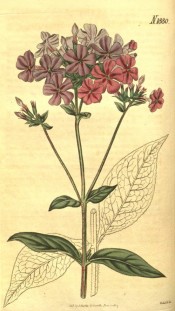Phlox paniculata L. var. grandis
Fully hardy, erect, herbaceous perennial with lance-shaped, toothed leaves, to 13cm long, and panicle-like cymes of salverform, fragrant flowers, to 2.5cm across, in shades of white, pink, lilac, orange or red, often with a contrasting eye, from summer to autumn. To 1.2m. The name grandis suggests a tall-growing or large-flowered form. I have found no specific reference to the variety. [RHSE, Hortus].
Horticultural & Botanical History
There are many garden cultivars, and horticultural forms are often known as Phlox decussata. Introduced to Britain in 1732. [PD]. ‘Native of Georgia and South-Carolina. Rather more tender than many other species. Flowers in August and September. Introduced by the late Mr. Lyons, in 1812 [as Phlox acuminata]. Communicated by Mr. William Kemp, of Clapton, in September 1815.’ [BM t.1880/1817].
History at Camden Park
Listed in the 1857 catalogue [T.750/1857] but certainly grown by 1853 as plants were sent to the Sydney Botanic Garden in that year. [RBGS AB].
Notes
Published Mar 03, 2009 - 04:38 PM | Last updated Feb 28, 2010 - 11:01 AM
| Family | Polemoniaceae |
|---|---|
| Category | |
| Region of origin | Eastern USA |
| Synonyms |
|
| Common Name | Perennial phlox, Summer phlox, Autumn phlox |
| Name in the Camden Park Record | Phlox paniculata grandis |
| Confidence level | high |


